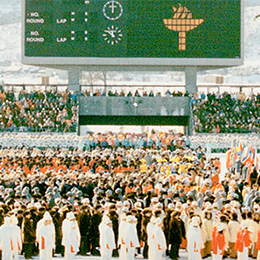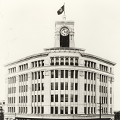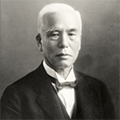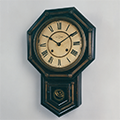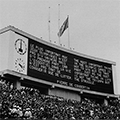Seiko has created a great number of epoch-making products, and therefore, many people believe that Seiko is a “technology-oriented” company. However, Seiko is also the manufacturing–oriented company that has focused on “superior and sophisticated manufacturing” as its basic policy since the company’s foundation.
Even if there are good ideas, we can’t deliver any product to our customers without people who give them "a form."
Seiko has considered that “manufacturing” is “nurturing people” and made efforts to develop excellent engineers and craftsmen. The “Great Craftsperson in the Present World” comprised the heart of our efforts. It goes without saying that the “Great Craftsperson in the Present World” introduced in this section are representatives of a lot of engineers and craftsmen.
Company name: SE: Seiko Epson Corporation SII: Seiko Instruments Inc. SSC: Seiko Service Center Co., Ltd.
Reference: Company magazines of Seiko Group, Press releases, THE SEIKO BOOK (Tokuma Shoten)
1. Challenge to Domestic and International Accuracy Competitions
Actively having entered the domestic and international precision competitions, Seiko improved its technology and skill, and developed human resources. In Japan, Seiko had entered the Council for Quality Inspection of the Japan-made Watch and Clock (timepiece competition) since 1948, and after introduction of its first product created from proprietary Seiko technology called “Marvel” in 1956, Seiko had continuously dominated in competitions in the watch industry. Seiko’s technology and skills created Grand Seiko released in 1960.
Then in 1963, Seiko participated in the Observatory Chronometer Competition in Switzerland, the highest peak of accuracy competitions in the world.
Although having a tough time in the first years, Seiko finally won the high place in the competition in 1967, and also demonstrated the best accuracy coordination ever recorded in 1968.
(Seiko had entered in the Neuchâtel Observatory Chronometer Competition till 1967, and in the Geneva Observatory Chronometer Competition in 1968. The testing standards are same.)
Movements demonstrated the best accuracy adjustment ever recorded at Geneva Observatory Chronometer Competition in 1968

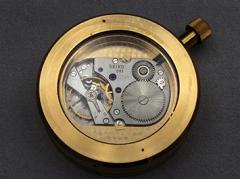
Table of results
Precision is largely dependent on capacities and skills of coordinators. In the table of results at the Geneva Observatory Chronometer Competition, the coordinators’ names are printed with reverence.
| Company name | Name |
Company entry/Year received Great Craftsperson in the Present World |
Remark |
|---|---|---|---|
| SE | Kiyoko Nakayama |
1943/1971 |
A 1st Grade Certified Skills in Watch Repair, which included very few women, and involved in the assembly and adjustment of various mechanical wristwatches ranging from those of small size for women through to the Grand Seiko series. She received the movement adjustment prize at the Geneva Observatory Chronometer Competition held in 1968, which was a first for a woman. |
| SE | Tokuichi Inagaki |
1953/1973 |
Participated in the Neuchatel Observatory Chronometer Competition of 1967 and the Geneva Observatory Chronometer Competition of 1968. At the Geneva competition his adjusted timepiece had the best record of all mechanical watches, and he received five of the nine Series Prizes related to mechanical watches adjustment in the wrist chronometer division. |
| SII | Sohachiro Nomura |
-/1974 |
Received the movement adjustment prize at the Neuchatel Observatory Chronometer Competition of 1965 as the first Japanese. His prizewinning meant that the result of a marriage between timepiece theory and adjustment skills became accepted, and which proved to be very significant. |
| SE | Kenichi Koike |
1955/1987 |
Received three of the nine Series Prizes related to mechanical watches adjustment in the wrist chronometer division of the Geneva Observatory Chronometer Competition of 1968. Also provided guidance to entrants in the Skills Competition, and contributed to improving the precision of mechanical timepieces while also decreasing the weight and size of quartz watches. |
Kiyoko Nakayama
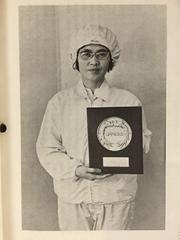
Kiyoko Nakayama was given the award of “Great Craftsperson in the Present World” as the first woman awardee in 1971, and received a memorial plaque and certificate of commendation as “excellent technician” from the Minister for Labour.
Bibliography
・Company magazine “Suwa Seikou”
・SEIKO BOOK Tokuma Shoten
The good results in the Observatory Chronometer Competition in Switzerland meant that Seiko reached the quality of watches made in Switzerland and finally took the world’s No. 1 and remarkably encouraged the Seiko workers. The technical skills improved in the competitions greatly helped promotion of subsequent “manufacturing” (mass production).
2. Mass-production of Highly Accurate, High-Quality Wristwatches
To deliver highly accurate technology and skill to many people, it is essential to improve manufacturing and processing technologies for watch parts and to develop mass-production technologies and production devices.
This section introduces Seiko’s “Great Craftsperson in the Present World” who supported highly accurate manufacturing and mass-production of parts for mechanical timepieces.
| Company name | name |
Company entry/Year received Great Craftsperson in the Present World |
Remark |
|---|---|---|---|
| SE | Isao Tanaka |
-/1984 |
Having been certified as having 1st Grade Certified Skills in Machining and also 1st Grade Certified Skills in Finishing he is an excellent trainer of junior colleagues. |
| SE | Sachio Kamano |
1947/1988 |
Engaged in the assembly adjustment of special watchmaking machines through use of technical skills that were acquired in machine and instrument assembly and machine finishing fields. Because of the aim to develop a machine that anyone can operate he has made the effort to computerize and standardize the feel and techniques of skilled workers. |
| SE | Senji Hosoya |
1955/1991 |
Successfully developed automatic production lines used for making watches and also IT and optical devices. One of his achievements as a excellent capability employee includes an "Innovative Parts-feeder" patent that involves parts being aligned using vibration. (Awardee of Okochi Memorial Grand Production Prize) |
3. Tokyo Olympics Games and Quartz Innovation/Diversification
When becoming the Official Timer of the Tokyo Olympics Games in 1964, Seiko developed timing instruments loading its quartz technology and other advanced technologies, which contributed to the first “no claim for timing” in the Olympics history, and raised a revolution in the official timing industry. After that, the SEIKO brand has been recognized widely all over the world, and Seiko’s “advancement and high quality” has been established as a corporate image.
Also, Tokyo Olympics Games brought new business opportunities among SEIKO factories that served as an official timer, and made great contributions to their growth.
Quartz Crystal Business
Development of “Crystal Chronometer” (small crystal quartz) used for the official timing led to commercialization of the world first quartz wristwatch “Astron” (1969).
Currently, 98% of all wristwatches are based on the quartz system and all of them are equipped with Seiko’s unique technologies (tuning-fork-type crystal oscillator and open type step motor).
In particular, the self-developed turning-fork-type crystal oscillator remarkable for its small size and high shockproof performance became the major technologies of the quartz innovation for wristwatches, and currently not only wristwatches, but also many electronic machines have them on board.
The section below introduces Seiko’s “Great Craftsperson in the Present World” who engaged in development of mass-production technologies of crystal oscillators.
| Company name | Name |
Company entry/Year received Great Craftsperson in the Present World |
Remark |
|---|---|---|---|
| SE (Toyocom) | Mitsuo Hara |
1971/2006 |
Engaged in the manufacture of devices used to produce crystal oscillators, a base component of quartz watches. Various devices based on his ideas have contributed to improving the productivity of processing and assembly lines during stepped-up production. Recently achieved significant energy-saving measures via adjusting and upgrading the devices. |
| SE (Toyocom) | Kenji Sakurai |
1981/2010 |
A multi-skilled worker who can coordinate mechatronics from designs through to software and hence has been engaged in automation, efficiency improvements, and energy-saving of production devices for a long period of time. The crystal oscillator production device he handled has contributed to significant reductions in the cost of products and the mass-production of new products via use of its unique technology and mechanism. He has been actively engaged in transferring his excellent knowledge, and nurtured a large number of technicians. |
| SE (Atmix) | Koichi Shibata |
2000/2010 |
Strove in the precise finishing area of the seal surfaces required in retaining the internal pressure of crystal growth furnaces over a long period of time, and successfully extended the life of devices while also improving the efficiency of repair work. He has also given lectures and life lessons at prefectural industrial high schools, thus contributing to the growth of possible successors. |
World Standard Technology of Quartz Astron
Tuning-fork-type crystal oscillator

・Its turning-form shape, instead of a bar shape, allowed “compact size,” “shockproof,” and “stable oscillating.”
・Development of the photo lithography manufacturing method allowed complicated processing to form its shape.
・Development of thermo-variable condenser improved temperature characteristics.
Open type step motor

・By separated allocation of the rotor and the coil, the motor can be small in size.
・Development of the one step/second ticking beat moving system allows a small size and energy-saving.
Printer Business
Seiko developed “Printing Timer” which printed measurement results immediately. It was a special innovative timing instrument that had a great impact on the timing systems.
On the other hand, those printing timers created business opportunities, leading to the printer business later.
| Company name | Name |
Company entry/Year received Great Craftsperson in the Present World |
Remark |
|---|---|---|---|
| SE | Sadaaki Sakai |
1970/2007 |
Having engaged in the development of devices used to produce watches, printers, optical devices, and crystals etc. he has been promoting the development and manufacture of a device that will fulfill the required accuracy of 1/10,000 mm which has arisen in recent years. His "development of electronic device production technology that utilizes the inkjet system" received the Excellence Prize of the 1st Monozukuri Nippon Grand Award in 2005. |
| SE | Takashi Iimori |
-/2008 |
Engaged with molds for a long period of time and acquired excellent levels of skill in the finishing, assembly, and adjustment of presses and plastic molds. His highly precise plastic and metal production skills have been highly appreciated. Just one of his achievements includes the non-coated printer case. |
Optical Plastic Lens Business
Seiko worked on self-manufacturing of engineering (reinforced) plastic used for quartz wristwatches. Based on its accurate molding technology, Seiko became the first Japanese manufacturer that successfully developed and manufactured “plastic lenses.”
After that, Seiko developed the Japan’s and world’s first lenses, leading the business of plastic lenses for glasses. The section below introduces Seiko’s “Great Craftsperson in the Present World” who supported manufacturing of those lenses.
| Company name | Name |
Company entry/Year received Great Craftsperson in the Present World |
Remark |
|---|---|---|---|
| SE | Masashi Kamata |
1957/2001 |
After being involved in the processing and assembly of jigs, he then took charge of the production lines and supply systems used in producing watches, contact lenses, and printers. He received the Okochi Memorial Production Prize in 1990 for the "development and practical application of an automatic contact lens production line." |
| SE | Takeshi Kitazawa |
1960/2005 |
Engaged in the processing technology operations in producing precision components and jigs that consist of rationalization machines for watches, printers, plastic injection molding and press molding systems. He has also contributed to the development of the current rationalization lines used with watches and printers and an "automatic contact lens production line." |
| SE | Tsuneo Iezuka |
1965/1998 |
Put a lot of effort into the development and practical application of precision equipment that includes accuracy measurements and the analysis of machines used to manufacture glass lenses, contact lenses, and liquid crystal panels. He innovated a method of measurement that was difficult in contact lens and glass lens production lines, thereby making a major contribution to the mass-production of them. |
4. Efforts to Produce Luxury Wristwatches
In the middle of 1980’s, the Swiss watch industry cultivated a new “luxury timepiece” market with the manufacturing system and promotion of brand authority and rarity value created by excellent ornamental designs and high quality of products made by hands of craftsmen, attaching full weight to the long history and traditions mechanical timepieces uniquely had.
In 1988, Seiko revived Grand Seiko for the first time in 15 years, and made full-scale efforts to manufacture luxury watches including Credor, based on the latest technology and traditional skills, keeping a distance from the Swiss watches.
Seiko developed the highest quality quartz, highly accurate hi-beat mechanical and high-class movements driven by the third method called “Spring Drive,” and brushed up its master craftsmanship to improve fineness and the quality of processing and finishing performances. As a result, Grand-Seiko has grown up to be one of the biggest brands.
Seiko’s “Great Craftsperson in the Present World” supported manufacturing of them.
Also, a designer of Grand Seiko was awarded as “Great Craftsperson in the Present World” for the first time in the industry.
| Company name | Name |
Company entry/Year received Great Craftsperson in the Present World |
Remark |
|---|---|---|---|
| SII | Mamoru Sakurada |
1965/*1999 |
Having been engaged in the assembly and adjustment of mechanical wristwatches he then went on to establish techniques for those operations, and made significant contributions to the training and nurturing of younger generations. He is capable of manually assembling the ultra thin movement of 1.98mm in increments of 1/100mm, and while correcting components without decreasing their precision. |
| SII | Kiyoshi Terui |
1970/2002 |
Having been engaged in processing of outer cases and dials etc., he has also constantly innovated and improved upon a number of ideas. He first commenced upon the metal carving of mechanical wristwatches in 1995, and contributed to improving the values of domestic wristwatches as craftwork, and the recovery of the status of mechanical wristwatches. |
| SE | Kenji Shiohara |
1976/2003 |
A gold medalist of the National Skills Competition and World Skills Competition. After winning the prize he then joined in the launching of a number of new products. As a member of the Certification Committee of watch skills tests in Nagano prefecture he has also actively worked on training and nurturing engineers. (Spring Drive, Sonnerie) |
| SE | Kazuo Takeoka |
-/2006 |
Won in the watch repair division of the "World Skills Competition in the Netherlands, 1977" as the first Japanese winner. While playing a part of the growing watch business via use of his excellent techniques and skills he has also put a lot of effort into training younger generations. He is the main member of the promotors of the "Certified Skilled Worker of Shinshu Artisanal Watch Repair" system, and has contributed to the overall growth of the watch industry. |
| SE | Yoshifusa Nakazawa |
-/2008 |
Engaged in watch assembly adjustment work, and contributed to the luxury watch field via efforts made in the pursuit of high quality, established assembly techniques, and helped train younger generations. He was a champion in the watch repair division of the World Skills Competition in 1981. He was an exclusive assemblyman of the world's thinnest movements for quartz watch models in 1988, and an assembly adjustment of the final phase of the ultra-complicated watch of the "Credor Spring Drive Sonnerie". |
| SII | Kazushi Kannondou |
1971/2009 |
Engaged in watch assembly adjustment work, of luxury mechanical watches that include the Credor and Grand Seiko, and timepieces that are also equipped with a chronograph function. He is a member of the Certification Committee of the national skills tests for watch repair, and has also put a lot of effort into generalizing and transferring the assembly and adjustment skills needed with mechanical watches through internal training. |
| SE | Katsumi Nakata |
1982/2010 |
Engaged in watch assembly adjustment work, and contributed to the luxury watch field through efforts put into the pursuit of high quality, the establishment of assembly techniques, and the training of younger generations. He was a champion in the watch repair division of the National Skills Competition of 1984. He has been an exclusive assemblyman of luxury watches that include the Spring Drive complicated luxury watch in 1999. His artisanal partial finishing of watches has been extremely well received both domestically and internationally. |
| SSC | Osamu Sasagawa |
1994/2013 |
With advanced repair and assembly adjustment techniques used in not only antique watches but also the latest complicated wristwatches he is also a former champion of the national watch skills competition, and a leading authority in watch repairs. He has widely contributed to the development of the watch industry, and the growth and training of following technicians. |
| SE | Ikukiyo Komatsu |
1982/2014 |
Has delivered results in the training and development of watch technicians as an instructor, and also significantly contributed to the growth of the nationwide watch industry, while also improving technical aspects of the industry as a competition committee member, has demonstrated assembly techniques with respect to luxury watches in both Japan and other countries, and enabled a large number of people to realize the magnificence of a fine mechanism, the appearance of a luxurious finish, and extremely difficult assembly techniques, thereby improving the Japanese brand recognition and increasing their sale. |
| SII | Nobuhiro Kosugi |
1993/2014 |
Has been engaged designing watches for 40 years now, and has recently taken charge of the design work of mechanical models, in particular the Grand Seiko. He has given earnest consideration to the glitter and reflection of stainless steel and precious metals, and pursued the form of wristwatches to the utmost limit, and accordingly established unique Japanese beauty with respect to both the watch case and bracelet designs. He received the "Great Craftsperson in the Present World" award for the first time as an industrial product designer. |
| SII | Satoshi Hiraga |
1989/2015 |
Engaged in the assembly of mechanical timepieces, and established a record for bring a champion of the youngest age at a watch skills competition held in 1995 when he was just 25 years old. In recent years he has mainly been in charge of the Grand Seiko (e.g. Mechanical Hi-Beat 36000GMT), and joined the development phase of new products. Those products have been receiving high levels of acclaim in the market. |



